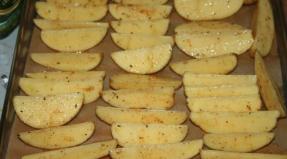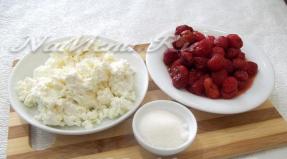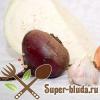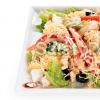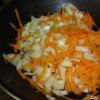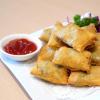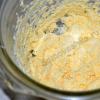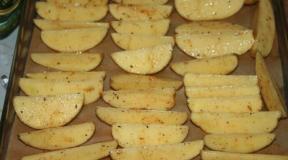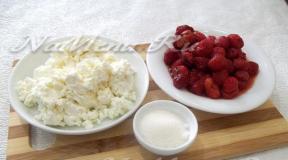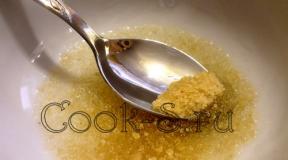Uzbek pilaf recipe with beef and chickpeas. Pilaf with chickpeas or oriental dishes in your family
The owner of my kitchen is my wife, she cooks excellently, and she can easily cook pilaf herself. But, once a week, as it happens, I am in charge of the kitchen and, at the insistence of my family, I cook pilaf myself.
Having purchased the necessary products and carefully prepared for the upcoming process, I begin to cook, trying not to miss the slightest error. I won’t say loud words, but judging by the reaction of those around me, it seems to be not bad...
I would like to immediately clarify and clarify that this is not the legendary “Sophie Osh”, which has no equal, and I think that pilaf connoisseurs will agree with this. After all, even in Bukhara itself there are several types and methods of preparation. The pilaf recipe, what we will cook with you will be somewhat reminiscent of “Sophie Osh”, but only in a more simplified version.
Pilaf with raisins recipe with step-by-step photos
First of all, in order not to forget anything during the process, you should prepare all the necessary products: rinse, peel, chop and then put a kettle of water on the fire for further soaking the rice.- To prepare pilaf we will need:
- Cottonseed and linseed oil - 600-700 gr.
- Meat - 500-800 gr. (More is possible)
- Lamb tail - 200 g.
- Onions - 2-3 heads
- Carrots - 1 kg.
- Garlic - 2 heads
- Rice - 1.5 kg.
- Round peas - 100-200 g (about half a 200 g glass)
- Yellow raisins (special for pilaf) - 50-100 g.
- Zira - 1 teaspoon
- Salt - 4 tbsp. spoons

In very hot oil, fry the meat along with the fat tail, cut into large pieces. It is important to know that meat retains its juiciness more when cut large. It is necessary to fry the meat and fat tail over high heat, the process should occur quickly enough, 2-3 minutes, to form a fried crust of a faint ruddy color.

Next, add the chopped onion, not very thinly, and reduce the heat to low, close the lid tightly and leave to simmer for 5 minutes. Do not overcook the onion, releasing moisture during the cooking process, the onion will not allow the meat to burn.

Then add the carrots, pre-cut into strips, close the lid tightly and leave to simmer over low heat for 30 minutes.

By this time, the boiling water that we set at the beginning should already be boiling. Before pouring boiling water, put 2 tablespoons of salt on a cup of rice, pour hot water just above the surface of the rice and immediately put the water back in the kettle to boil, for further pouring into the cauldron. Leave for 20-30 minutes while the carrots simmer.

After 30 minutes have passed after adding the carrots, add pre-soaked Peas and Raisins, Zira and Garlic. Peas are soaked at least 3-5 hours before cooking. Cover the cauldron tightly with a lid and simmer for another 10 minutes.

Meanwhile, rinse the rice with cold water 3 times. Then put the rice in the cauldron, add a little more cumin, add salt - 2 tablespoons.

Pour boiling water over a ladle to avoid partial boiling of the rice. Set the heat to maximum and patiently stir just the rice.

As soon as the water is absorbed, close the cauldron with a lid and vigorously steam the rice for 5 minutes. Then, slightly reducing the heat, open the lid of the cauldron and thoroughly mix only the rice, round it into a ball, and make through holes with a long knife to allow steam to circulate.

Close the lid of the cauldron tightly, reduce the heat to low and leave for 20-30 minutes. Patiently, without opening the lid, we courageously bide our time. In the meantime, prepare salads for pilaf and set the table.

Having mixed the required amount of rice, first spread the rice in a not very thick layer, put carrots on top of the rice, then fat tail meat and garlic.

And for drinks, “properly” brewed hot green tea from selected varieties is served with the dish.
It turns out with a certain sweet aftertaste. Dried fruits radically change the usual taste. And to know all the charm of this wonderful dish, you should definitely try it.
Based on this recipe, we have created a demonstration video, which shows the whole process in practice without words. Based on this recipe and viewing
Views: 15155Nokhatli palov, or Pilaf with chickpeas, is one of the varieties of Uzbek pilaf. This type of pilaf is called differently, for example, Ivitma palov - pilaf made from soaked rice with peas, or Nokhatli kavurma pilaf - fried pilaf with chickpeas. By the way, in Uzbekistan, according to various estimates, there are from 40 to 60 types of pilaf. Of course, the most famous and popular, especially outside of Uzbekistan, are the classic types of pilaf, or, as they are called, “basic”, for example,
Devzira pilaf (Fergana style pilaf), which consist only of rice, preferably the best (red Devzira), meat (preferably lamb), vegetables (onions, carrots). The remaining types of pilaf are variations of the classic options. For example, pilaf with meat substitutes (chicken, sausage, game, chicken or quail eggs, dolma, meatballs and even fish). Or with other vegetables instead of carrots (turnips, radishes, beets and whatever else comes to hand), or with rice substitutes (noodles, pasta, wheat and even buckwheat). Melted fat tail fat is replaced with vegetable oil, for example,cotton. There are mixed pilafs, when legumes (for example, mung beans, chickpeas, peas or beans) are used in addition to rice. There are even sweet types of pilaf - with fruits (berries or dried fruits).We offer a version of classic pilaf with the addition of chickpeas. This type of pilaf can be considered everyday. Getting ready pilaf with chickpeas almost the same as the famous oneFergana style pilaf (Devzira pilaf), only the amount of rice is taken less and chickpeas are added. Lamb is preferable as meat for pilaf with chickpeas, although beef will also work well. Fat tail fat can be replaced with cottonseed oil. And instead of expensive red Devzira, they take simpler and cheaper rice, for example,bright Devziraor rice laser. This pilaf has another interesting feature - the meat is cooked in large pieces, and then, after the pilaf is ready, the meat is removed and cut into small pieces, which are added on top of the rice when serving. The pilaf turns out to be satisfying and less expensive than Fergana-style pilaf. It is difficult to argue with the point of view that Fergana-style pilaf is the most delicious. But even in everyday life, people prepare their everyday food more simply than their holiday food. And pilaf with chickpeas, although less bright, is nevertheless not much inferior to the recognized leader among Uzbek pilafs. It’s worth a try, maybe this type of pilaf is most suitable for your family?
We will need (for 4 servings):
Soft rice (eg.
devzira light or laser) - 500 g,. meat (lean lamb or beef) - 400 g,
. chickpeas- 100 g,
. vegetable oil (egcotton) - 150 g,
. carrots - 200 g,
. onion - 2 pcs. (or 300 g already peeled),
. barberry- 1 tbsp,
. cumin- 1 tsp,
. turmeric- 1 tsp,
. ground coriander- 1 tbsp,
. ground red pepper- 1 tsp,
. salt - 1 tsp. (or to taste).
|
The recipe for this pilaf differs from other pilafs only in that in addition to rice, the pilaf contains chickpeas. These peas are very durable, not prone to boiling, and must be soaked before cooking. Chickpeas are extremely hygroscopic and expand almost 4-5 times during soaking. You need to take 6 times more water in volume than chickpeas. |
 |
|
Next you can do the rice. Chickpea pilaf is an everyday pilaf, and it is prepared from inexpensive pilaf rice, which is what light devzira is, or, alternatively, Laser rice. And such (everyday) pilafs are most often prepared not with melted fat tail fat, but with vegetable oil and, again, most often with cottonseed oil. |
 |
|
Wash the carrots (an essential component of Uzbek pilaf), peel the top layer (like potatoes) and cut into “peas,” that is, into cubes 1x1 cm or so. |
 |
|
Peel the onion (an essential component of Uzbek pilaf) and cut into thin rings, about 0.5 cm. |
 |
|
Rinse the meat, dry with a paper towel and cut into pieces of approximately 100-150 grams. The meat in this recipe is prepared in relatively large pieces; the fact is that before serving, the meat is taken out of the pilaf and cut into small pieces and placed on top of the pilaf when serving. Lean beef or lamb is suitable as meat (it is preferable). |
 |
|
Measure out the required amount of spices and seasonings. |
 |
|
Uzbek pilaf cannot be cooked without fat. The best fat for pilaf is rendered fat tail fat. But, as mentioned above, this is not a cheap product, and everyday pilaf can be prepared with cottonseed oil. Place a clean cauldron on the stove, pour cottonseed oil into it and turn the heat underneath to maximum. Heat the oil until it produces a whitish haze. |
 |
|
Now we put pieces of lean lamb (or beef) into the cauldron and continue to fry further (at maximum heat) for about 3-5 minutes, then you need to mix the contents of the cauldron (this will allow you not to lose the temperature of the oil). Fry the meat until lightly browned. |
 |
|
Add onion to the cauldron. Fry the onion, stirring occasionally, until softened. This, by the way, will take some time, about 5 minutes or so. |
 |
|
As soon as the onion softens and begins to change color, add the carrots and fry for 10-15 minutes. |
 |
|
Add soaked chickpeas to the cauldron (drain the water first and rinse with running water). |
 |
|
Add turmeric, cumin, ground coriander, ground red pepper, barberry and salt to the cauldron. |
 |
|
Add enough cold water to the cauldron to cover the contents of the cauldron, and bring the liquid to a boil. |
 |
|
Reduce the heat to low and cook zirvak (the so-called gravy in which the rice will then be cooked) for 20-25 minutes. There is no need to cover with a lid. After time has passed, taste the broth and chickpeas. The broth should taste like vegetables, seasonings, and meat. If necessary, add salt to the zirvak; the taste of the zirvak should be a little saltier than regular food. Rice and chickpeas will absorb some of the salt. The chickpeas should be softened and almost ready; when the rice is cooked, they will be ready. |
 |
|
Now it's time to put rice in the cauldron. The rice is already soaked, drain the water and rinse it again. The rice is almost snow-white, with a pearlescent tint. Although light devzira is the cheapest pilaf rice, it is nevertheless a good rice for pilaf. If you wish, you can use Laser rice; it is of higher quality, although this can most likely only be assessed by specialists, and is somewhat more expensive. |
 |
|
Under the cauldron, increase the heat to maximum and load rice into the cauldron, carefully level it in the cauldron with a slotted spoon. |
 |
|
And, if necessary, add hot water from the kettle so that it covers the rice and is about 1 cm higher than the rice level. If in the future it turns out that there is not enough water, you can add it a little. This is not advisable, but it is possible; in any case, it is better than burnt pilaf. |
 |
|
Wait for the liquid to boil intensely; this will facilitate greater absorption of zirvak by the rice. The zirvak should boil evenly over the entire surface. Do not cover the cauldron with a lid. Wait for the water to boil. There is no need to stir the rice. |
 |
|
After some time, the water has evaporated, at least most of it, and the rice and chickpeas are almost cooked; if you try them, the rice should be slightly hard, but without crunch, and the chickpeas should be soft. There is no need to worry about chickpeas that they will be overcooked and mushy. Chickpeas are peas that are not at all prone to overcooking. |
 |
|
Using a slotted spoon, carefully scoop the rice from the edges of the cauldron towards the middle. |
 |
|
Using a wooden stick (for example, for sushi), we make several punctures in the rice to the bottom (so that steam escapes). Cover the cauldron with a lid, turn on the smallest fire under the cauldron and continue cooking the pilaf for about 15-20 minutes. |
 |
|
Open the lid and admire the result of your labors. Turn off the fire under the cauldron. Gently mix the pilaf. |
 |
|
Remove pieces of meat from the pilaf. |
 |
|
Cover the cauldron with pilaf and leave to stand for 5-10 minutes. Cut the meat into small pieces. |
 |
|
We place the finished pilaf on a round serving dish, the Uzbeks call it lyagan. We put some of the pieces of meat on top of the pilaf, and what doesn’t fit, we put around the “mound” of rice. The result is a wonderful, aromatic, crumbly Uzbek pilaf, in which rice alternates with chickpeas. Chickpeas add extra filling to this pilaf. |
Culinarily, Uzbekistan is a country that can be divided into several different culinary regions. Ancient Khorezm, brilliant Tashkent, most fertile Fergana, magnificent Bukhara, exotic Surkhandarya and the sweetest, most fragrant of Uzbek cities - Samarkand.
Believe me, I'm telling the truth! Everything in Samarkand is special - the air itself, the water, the people, the history. How could it be that Samarkand did not have a unique culinary experience? Could it be that the ancient crossroads of trade routes, the meeting place of all surrounding civilizations, would not become a haven for the most talented chefs? Could it happen that Samarkand did not give birth to something unique in culinary terms? It couldn’t - it’s completely understandable! And will it be a revelation for you if I say that the main culinary heritage of Samarkand is Samarkand pilaf?
In fact, at least three types of pilaf are prepared in Samarkand. But today we will talk about only one of them, because this type of pilaf seems to me to be quite simple in execution, but very effective. People inexperienced in cooking will say: Well, what is there? Pilaf is pilaf! Meat, onions, carrots and rice - what new can be invented here? Don’t subtract or add, no matter how you cook it, it will all turn out the same! Can you guess how wrong people are with such a simplistic approach? When comparing the ingredients for a dish with the notes, can you imagine how many different melodies you can put together from them? And, of course, anyone more or less familiar with cooking is well aware that completely different dishes can be prepared from the same products. So let's get started?
Let's first decide what we need to prepare this pilaf.
- Rice. Rice for pilaf in Samarkand does not necessarily have to be dev-zira. It is better to take Khorezm starchy, sweeter varieties. Of the ones presented here, I would recommend Avant-Garde or Lazarus as a holiday option. They absorb slightly less water and fat compared to dev-jeera, so instead of the usual kilogram of rice, let's take 1 kilogram 200 grams of rice.
- But compared to Fergana pilaf, you can take less oil - 200 ml of vegetable oil or 200 grams. fat tail fat will be quite enough.
- Three or four onions, a kilogram of carrots, four heads of garlic, three or four capsicums and a glass of soaked chickpeas - that’s what we need in addition to one and a half kilograms of meat, which will contain not only pulp, but also meat on the bone. By the way, from which part of the carcass this meat will be taken is almost not critical, unless you count the horns and hooves as meat :)
- So, to begin with, we cut the carrots and onions into rings in a familiar way, peel the top husks of the garlic heads, render the lard or calcine the oil if necessary. Here's the meat. We do not cut the meat into small pieces, but divide it into several large parts of 400-500 grams.
- Place the meat in well-heated oil and let it brown properly and cover with an even crispy and aromatic crust. During this time, salt the meat and pepper it with black pepper. You should add about a third of the amount of salt that you prepared for this dish. Usually for this amount of food I use about two tablespoons of salt with a little top.
- To the already fairly fried meat, add all the onions and two handfuls of carrots, after which we continue to fry, slightly reducing the heat under the cauldron. Fry until the onion is browned and begins to melt. And during this time the carrots should fry very well, become soft and smell.
- What changes when we cook meat, frying it in small pieces or large pieces? When cutting finely, in addition to the fact that the meat is fried somewhat faster, the area of contact between the meat and the oil increases. The meat imparts much more of its flavor into the oil, and the oil will subsequently transfer the taste of the meat to the rice. By cutting the meat coarsely, the meat remains juicier, but the flavor of the meat itself remains within it, leaving the rice with its own taste.
- At this moment we must have boiling water on hand. Because now is the time to lower the rest of the carrots, level them (but do not mix them), scatter peas on top, distribute garlic and pepper among the carrots, sprinkle everything with cumin, etc. add water immediately. That is, do not wait until this second part of the carrots is fried, but immediately add water. Please note - do not fill it, do not pour it with water, but just add it: move away part of the carrots with a slotted spoon and pour water under it, so that most of the carrots remain on top of the water, and even more so, the peas.
- Now reduce the heat to less than medium and cover the cauldron tightly and leave it for thirty to forty minutes. During this time, the meat at the bottom will be stewed, and the carrots at the top will be steamed and cooked. You know, it's an amazing thing. Usually, chickpeas, even well-soaked ones, have to be cooked for quite a long time. But after spending some time steaming and then cooking under a layer of rice, these peas cook much faster - an hour, maybe an hour and a half, is enough for the peas to be completely ready!
- During this time, wash the rice. Did you notice that this time I didn’t encourage anyone to soak this rice? Because you shouldn’t do this with soft varieties of rice. Just rinse in running water until the water is absolutely clean. We also need to prepare about 1.5 liters of boiling water, which we will salt with the rest of the salt.
- Let's open the cauldron, once again level all the products over its surface without mixing anything and put the rice in the cauldron. Distribute it evenly over the surface of the cauldron and pour in the salted boiling water that we prepared ahead of time. Please note that we only salted the meat, now the rice is salted, but the carrots are almost ready and they were cooked without salt! Pour salted boiling water over the rice, add heat and let the water boil over the entire surface of the cauldron. When the water begins to leave the surface of the rice, we will need to shovel the rice once: carefully lifting the layer of rice (trying not to touch the layer of carrots and peas), turn it over, lowering the top of the rice down, where there is still water and oil. After making sure that almost all the water has evaporated, we collect the rice in a heap and carefully, so as not to pierce the capsicums that are under the rice, we make holes in the rice layer. Let's wait until all the water has boiled away and, reducing the heat to low, cover the rice with a bowl. By the way, with soft varieties of rice it is better not to cook them, like dev-jeera or basmati, almost to the end, but leave them half-cooked, al dente, so to speak.
- Why do we pour salted boiling water over rice? Because in this pilaf, the rice is not dipped into the zirvak, which contains a fair amount of already salty broth, but the rice is placed on top of the almost dry zirvak - meat, onions and steamed carrots. The idea of this dish is not to mix either the products themselves or their flavors with each other. Therefore, rice should be salted separately. Trying to salt rice with dry salt may result in the rice being over-salted in some places and under-salted in others. Salting with boiling water is a great solution for this situation! In addition, this method will allow you to salt the rice, but leave the carrots with their original sweetish taste. Believe me, this is also very good!
- After waiting the required thirty to forty minutes, we open the pilaf. and do not mix under any circumstances! Have you prepared dishes for distributing pilaf? Place all the rice among these dishes. After this, lay out the carrots and peas in a neat mound, garnish with garlic and pepper, and place a piece of meat on one side of the dish. Along with each dish of pilaf, a board and a knife for cutting meat are served to the table.
The meat turns out to be quite juicy and soft inside, while remaining a beautiful red color; the carrots are somewhat sweeter compared to Fergana-style pilaf, because it has almost no salt. The rice remains a little drier, but each eater can adjust its fat content individually by adding the required amount of carrots or meat to each spoonful of rice. In general, it must be said that this pilaf is much more dietary and easy to digest, but, nevertheless, in Samarkand it is usually prepared only before lunch - the deadline when you can eat Samarkand pilaf is noon.
We already had it, but here’s how to cook delicious Uzbek vegetarian pilaf, Anetta, a regular reader of the site, shared with us.
Anetta writes:
Previously, I cooked meat pilaf in such a way that even experts almost swallowed their tongues and praised it, but now vegan pilaf is swept away.
And I have no doubt about it! And thanks to her detailed description, advice and step-by-step photos for the recipe, I’m sure ours will turn out very tasty too.

But before you start preparing vegetarian pilaf with chickpeas, read a few recommendations from Anetta:
Pilaf– the dish is not only tasty, but also quite simple to prepare. In order to get exactly pilaf, and not “shawl”, that is, porridge with additives, it is necessary to cook it in a thick-walled cauldron or, as I do, in a cast-iron pan with a lid that expands at the top, like a cauldron.
For pilaf they use Uzbek rice - devzira, which can be bought at the market or in departments selling oriental exotics, but can be replaced with basmati rice, brown rice or any high-quality, non-overcooking variety.
Compound:
- 2 cups rice (devzira, basmati or any non-cooked variety)
- 1/2 cup chickpeas
- 3 medium carrots
- 2 large or 3 medium onions
- 1 head of garlic
- 1 cup odorless vegetable oil
- 1 cup (or handful) soy meat
- spices: 1 tbsp. spoon of barberry, 1 teaspoon of cumin (cumin), 1 teaspoon of ground red pepper, 1-1.5 teaspoon of asafoetida (instead of onion and garlic)
- 2.5 teaspoons salt
Preparing vegetarian pilaf with chickpeas:
- Soak it a day or two in advance.
 Turkish peas - chickpeas
Turkish peas - chickpeas
- The water must be changed every 4-6 hours to prevent it from turning sour. If the chickpeas stand for a day, then they swell, and if there are two, then a sprout begins to hatch. These chickpeas are more tender and tastier. (By the way, you can make very tasty dishes from chickpeas.)
 Soaked chickpeas for vegetarian pilaf
Soaked chickpeas for vegetarian pilaf
- Rinse the rice. Devzira needs to be washed up to 30 times, since this variety contains a lot of powder. Other varieties - less. While we add other products, the rice swells.
 Devzir rice
Devzir rice
- Peel the onions and carrots.
 Onions and carrots
Onions and carrots
- Cut the carrots lengthwise and then “flatten” each half. Using a sharp knife, cut diagonally into strips.

- Pour a glass of oil into the cauldron and bring it over high heat until it becomes overheated, possibly even with a slight smoke.
- Place the carrots in the oil and fry over high heat until they begin to turn light brown and the oil turns orange.

 Sautéed carrots
Sautéed carrots
- While the carrots are frying, cut the onion into half rings.
 Chopped onion for pilaf
Chopped onion for pilaf
- Add it to the carrots, add a spoonful of salt, stir and continue frying over high heat until golden brown.

- Put water in a kettle to boil.
- Prepare spices.

- Add seasonings (cumin, barberry, red pepper), as well as chickpeas and soy meat (dry), to the cauldron, mix everything. If you do not use onions and garlic, then also add.

- Place the rice in the cauldron so that it lies on top of the fried mixture without mixing with it.
 Layer of rice
Layer of rice - Stick a head of garlic, peeled from the outer husk, to the top of the head, add another 1.5 teaspoons of salt and carefully, so as not to wash out the rice, pour boiling water onto your finger above the level of the rice.
 Vegetarian pilaf - preparation
Vegetarian pilaf - preparation
- Now you need to close the lid, reduce the heat to the lowest setting and leave for 40-50 minutes. In my 2.5 liter cast iron pan, vegetarian pilaf is ready in 40 minutes.
 Kazan with pilaf
Kazan with pilaf
- When the pilaf is ready (it will make a dull sound when you tap it with a slotted spoon), it must be removed from the heat and stirred carefully.
 Vegetarian pilaf with chickpeas is ready
Vegetarian pilaf with chickpeas is ready
- The garlic is removed from the finished pilaf and thrown away - it is not eaten, it is only for flavor.

That's it, you can serve it! Bon appetit!
There are so many options for pilaf: using lamb, beef, pork, chicken, turkey, fish, seafood, vegetables, fruits and even dried fruits. In today’s article, we invite all true connoisseurs of this dish to prepare delicious pilaf with chickpeas.
Features of pilaf with chickpeas
Chickpeas (also called chickpeas or chickpeas) are a representative of legumes, and contain a lot of proteins and fats, amino acids, fiber, vitamins A, B, E, C and P. Chickpeas are low-calorie (no more than 120 kcal), helps with weight loss weight, good for digestion, heart function, kidneys and liver, cleanses the body of cholesterol.
The secret to perfect pilaf with this ingredient is simple: for chickpeas to be tasty, they should be soaked a day before the planned preparation of the dish. A large volume of cold water is required, since the nut will absorb some of it. To prevent the water from turning sour, you need to change it a couple of times or place the container in a cool room. Before cooking, chickpeas are washed with tap water.
It is better to buy brown rice for this dish; the alang variety is recommended. There are several ways to combine chickpeas with rice in a cauldron: you can put them in a mound in the center, cook them and then add them to vegetables, or place them in a container after soaking. A thick bottom pan is also suitable for cooking.
Carrots should be cut into long strips. It is better to add spices in the middle of cooking.
Video “Vegetarian pilaf with chickpeas in Uzbek style”
This video shows step-by-step preparation of vegetarian pilaf with chickpeas in Uzbek style.
Grocery list
Housewives, in search of a good recipe, look through a lot of sites because they want to cook a real culinary masterpiece. To prepare our version of the dish, you will need to prepare 700 g of lamb, the same amount of rice and carrots, 1 onion, 200 g of chickpeas (pre-soaked), 120 ml of vegetable oil. You also need 1.2 liters of boiled water, 1.5 tsp. cumin, bay leaf and salt (added to your taste).
detailed instructions
To begin with, vegetable oil is poured into the cauldron. Heat it over high heat, add onion, chopped into half rings, and stir from time to time. If the lamb is without fat, then the oil consumption will be up to 200 g. The butter is cut into medium-sized pieces. Before this, the meat is removed from the bones, whereas in traditional pilaf, cooked over a fire, the lamb is fried in large pieces and right with the bones.
The onion should be well fried, almost burnt - that’s when your favorite delicacy will acquire a bright appearance and an unforgettable taste. Afterwards it is laid out on a plate, and the meat is placed in a cauldron and cooked further, stirring. Next, the carrots are cut: first into plates, then diagonally at an angle of 45 °C.
When the lamb is browned, you need to add vegetables to the zirvak, that is, gravy, and mix. Frying is carried out until the carrots become soft. Next, pour in 800 ml of boiled water, add soaked chickpeas and bay leaves, mix and add salt. Cooking continues over medium heat with the lid loosely covered for about 45 minutes.
Rice is washed with cold water at least 3 times, soaked in hot water for 30 minutes. You need to add a tablespoon of salt so that the cereal does not turn out lean. Make the fire as high as possible, drain the water from the rice and place it in a cauldron. Next, pour another 350 ml of boiled water; the dish must not be stirred. If there is a lot of liquid, the pilaf will become porridge with meat; if there is not enough, the rice will be dry.
When swollen rice is visible in places on the surface of the pilaf, it needs to be swapped with the one that has not yet been saturated with oil and water, but only carefully. Next, you should make holes with the back of a spoon and make sure that only oil bubbles remain in them. The rice is laid out in the form of a slide; cumin can be placed on top of the slide or added to the gravy before laying out the rice.
Next, the dish is tightly covered with a lid, it should simmer for about 15 minutes. The finished dish is not mixed before serving, but removed in layers. Ideally, carrots should not break, but retain the shape of a straw.
What other ways are they prepared?
In addition to preparing traditional pilaf with chickpeas on the stove, modern housewives can make it in other ways. When using a multicooker, chickpeas are also soaked, boiled in it, then oil, vegetables, chicken fillet or other meat are added, 2 tbsp. l. tomato paste. Next, pour in 150–200 g of rice (after soaking), garlic, spices and salt. Fill with water and set the program for cooking pilaf, after which you can go about your business.
Try to prepare this wonderful dish at home, and you will definitely appreciate its taste, aroma and appearance.

